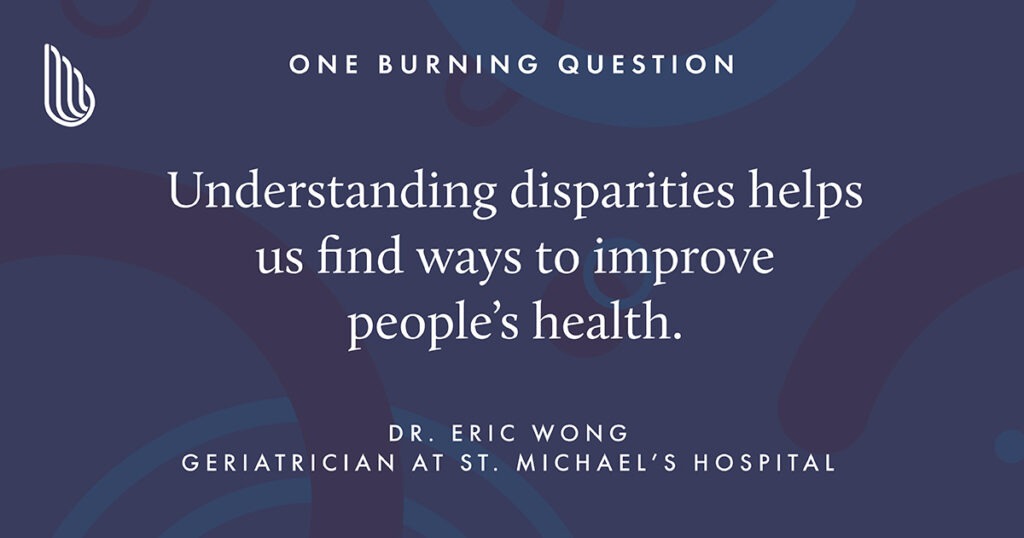Dr. Eric Wong’s #OneBurningQuestion: Do conditions like COVID-19 infections show up in unique ways in older adults?

Dr. Eric Wong’s patients are often curious about what it means to age healthily. They want to know what is considered normal. The truth, as highlighted by The St. Michael’s Hospital geriatrician’s research, is that there is a wide range of normalcy and possibility in geriatrics.
“I have patients who go to the gym and travel regularly. Those people remind me what aging can be,” said Wong.
But age and its related complications can also be a risk factor in medicine. In the early stages of the pandemic, Dr. Wong and other medical professionals saw how dangerous COVID-19 was for older adults, and how differently it could present in that demographic compared to younger ones.
This observation led to Dr. Wong’s latest research question: How common is it for older adults to present with atypical symptoms of COVID-19?
The discovery
In a study of patients with confirmed COVID-19 infections at seven Toronto hospitals between March 2020 and June 2021, Wong and his team examined the presentation of COVID-19 in patients of different age groups.
The research suggested typical symptoms of the infection in younger adults included fever, cough, shortness of breath, muscle aches and fatigue. But in older adults, categorized as those over the age of 65, symptoms like weakness, delirium and anorexia were more common.
Wong and his team noticed that the presence of atypical symptoms was related to frailty, which is more common in older age. Frailty, which is associated with a person’s fitness level, ability to care for themselves, dependence on others, physical health and mental health, is more common in older adults. The frailer a person is, the more likely they were to show symptoms that weren’t in line with those typical for COVID-19.
The presence of frailty was more related to atypical symptoms of COVID-19 than older age alone. Frailty, Wong and his team discovered, was also more closely associated with mortality than older age alone.
In the first wave of the pandemic, long-term care homes were hit the hardest, with older adults dying at higher rates than any other demographic. This wave was also when atypical symptoms were the most prevalent because older adults in long-term care were more frail.
The impact
Understanding and recognizing how disease presents in different populations and what the risk factors are for those populations can help physicians to catch illnesses at an earlier stage and start treatment more quickly, Dr. Wong says.
Dr. Wong was among the geriatricians who pushed for early vaccination for older age groups during the first few waves of the pandemic. In the second and third waves, after long-term care residents had been vaccinated, rates of infection and atypical symptoms in hospitalized older adults fell markedly. This was because of fewer long-term care patients requiring hospital admission after vaccination.
“We made a fundamental change for older adults because of those measures,” said Wong. “In research we try to address health disparities,” said Wong. “We look at a population with worse outcomes and try to figure out the reasons for this. Understanding disparities helps us find ways to improve people’s health.”
More #OneBurningQuestion articles
- Dr. David Gomez: How do we remove barriers to surgery?
- Dr. Darren Yuen: How do we treat the most common issue in kidney disease?
- Dr. Tara Kiran: How can we make patients’ first point of health care better?
- Dr. Sunit Das: How can we turn deadly brain cancer into a chronic and manageable disease?
- Dr. Sharmistha Mishra: What drives pandemics and why?
- Dr. Gaspard Montandon: Can we create pain killers that don’t kill?
- Dr. Joanna Sale: Can we stop devastating hip fractures?
- Dr. Charles de Mestral: How do we stop the most devastating outcome of diabetes and poor circulation?
- Dr. Cilia Mejia-Lancheros: How does mental-health related stigma affect homeless people?
- Dr. Yeni Yucel: Can the eye unlock secrets to ALS?
- Dr. Michael Cusimano: How do we stop injury?
By: Olivia Lavery
